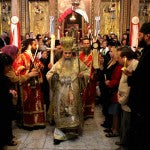 Greek Orthodox Patriarch Theophilos III leading the Divine Liturgy
Greek Orthodox Patriarch Theophilos III leading the Divine Liturgy
Image source: CNN
In terms of traditions, the Roman Catholic Church and the Eastern Orthodox Church developed separately due to the rift following the fall of the Roman Empire which paved the way to the Dark Ages. But even then, there had always been disparities in customs, especially those which pertain to the vestments they wear.
You may already be familiar with the liturgical vestments worn by members of the clergy in the west, but you probably don’t have any idea on the components of Eastern vestments. That’s why we’re going to take a look into the different articles of clothing worn by the clergy of the Eastern rite.
Pectoral Cross
 An Eastern pectoral cross.
An Eastern pectoral cross.
Image source: Photobucket
The Eastern clergy wear a pectoral cross around their necks. The name pectoral comes from the Latin pectoralis which means “of the chest” where the cross rests. Although the pectoral cross is worn by all bishops, it is not necessary for priests to do so.
An Eastern pectoral cross includes an image of a crucified Christ which may either be painted or in relief. Inscribed above the head of Christ are the initials INBI which stands for Iesous o Nazoraios o Basileus ton Ioudaion, which in English means “Jesus of Nazareth, King of the Jews.” The letters IC XC NIKA—common in Eastern iconography which means "Jesus Christ Conquers"—are also inscribed around the cross’s four arms.
The crosses may either be in silver or gold. A silver pectoral cross is given to a priest upon his ordination while a gold one is given to an archpriest to signify his position.
Sticharion
 A sticharion.
A sticharion.
Image source: GoPix
A sticharion is comparable to a Roman Catholic alb and is worn by all ordained ministers. Sticharions worn by priests are made from lustrous fabrics and may come in stark white or gold. They usually aren’t adorned. For deacons, sticharions are considered outer vestments. That is why they are composed of elaborate embroidery and color palettes reflecting the color of the day.
Epimanikia
 A pair of epimanikias.
A pair of epimanikias.
Image source: Wikipedia
Epimanikias are cuffs which are attached to the sleeves of the sticharion. Brocade is commonly used in crafting epimankias as the cloth needs to be thick. In most cases, crosses are embroidered at the center along with flowing patterns.
Epitrachelion
 An epitrachelion on display.
An epitrachelion on display.
Image source: Holy Trinity Cathedral
An epitrachelion is the Eastern version of the Roman Catholic stole. It is fundamentally worn around the neck with its two adjacent sides buttoned together. Like the epimanikia, epitrachelions are made from finely-woven brocade and has several crosses embroidered on the fabric. As Catholic priests don stoles during the Mass, Orthodox priests wear epitrachelions during the Divine Liturgy.
Zone
 A zone fastening the sticharion and the epitrachelion.
A zone fastening the sticharion and the epitrachelion.
Image source: Orthodox Wiki
A zone is a cloth belt used to fasten the sticharion and the epitrachelion together. As with the other pieces, it is made from thick brocade with an appliquéd cross in the center. A zone usually matches the color of the epitrachelion. It also signifies the strength of Divine Power bestowed upon the priest.
Phelonion
 A phelonion on display.
A phelonion on display.
Image source: Wikimedia Commons
A phelonion resembles a poncho, worn over a priest’s sticharion. The front is cut away to aid in the priest’s movement. The Roman Catholic equivalent of a phelonion is the priestly chasuble. It is adorned with embroidery of multiple cross, a pattern known as polystavrion.
Miter
 Metropolitan Seraphim of Pireaus wearing a miter.
Metropolitan Seraphim of Pireaus wearing a miter.
Image source: Mode of Life
Unlike in the Western Church, Eastern miters are worn by certain members of the clergy—including priests—as part of their ceremonial dress. Typical materials used to craft and decorate miters are brocade and damask. Golden cloth may also be used. Miters may be embroidered with golden flowers and decorated with jewels. Up front at the center are icons either of Jesus Christ, John the Baptist, or Mary the Theotokos.
As you can see, different traditions create diversity, especially when it comes to vestments. Nonetheless, the many distinctions allow us to appreciate the beauty in both the Eastern and Western ways.
References:


